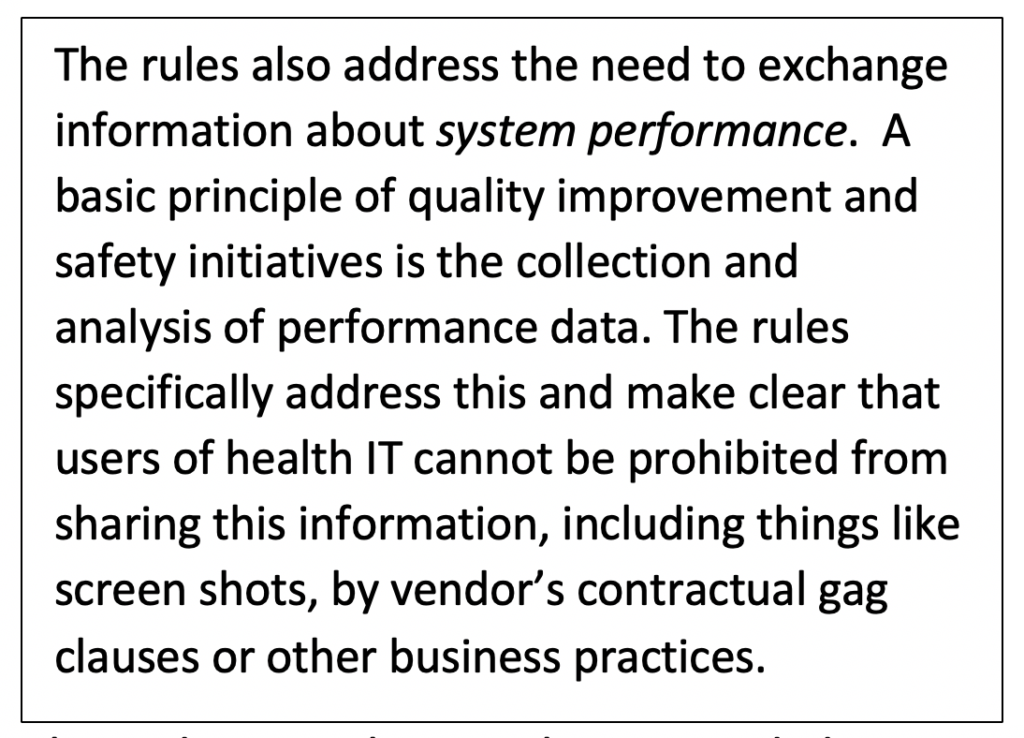

By DAVE LEVIN, MD and GRANT BARRICK
The Office of the National Coordinator (ONC) and the Centers for Medicare and Medicaid (CMS) have proposed final rules on interoperability, data blocking, and other activities as part of implementing the 21st Century Cures Act. In this series, we will explore the ideas behind the rules, why they are necessary and the expected impact. Given that these are complex and controversial topics open to interpretation, we invite readers to respond with their own ideas, corrections, and opinions. In part five of this series, we look at how competition unlocks innovation, and how the proposed rules may disrupt the balance between innovation, intellectual property (IP), and supporting business models.
____________
The recent publication of proposed rules by ONC and CMS set off a flurry of activity. In anticipation of their implementation, the health care industry is wrestling with many questions around business models. What practices inhibit competition and innovation? How do we balance the need for competition while protecting legitimate intellectual property rights? How can vendors ensure profit growth when pricing is heavily regulated? In this article, we will examine how competition unlocks innovation and the possible disruptions the proposed rules may bring for innovation, intellectual property (IP) and supporting business models.
Unlocking Innovation
via Competition
In most markets, innovation is driven forward by competition. Businesses compete on equal footing, and their investment in R&D drives innovation forward. Innovation in health care has been dramatically outpaced by other markets, leading to an urgent need for both disruptive and evolutionary innovation.
What is inhibiting health care innovation? The rules identify a combination of tactics employed in health care that restrict the free flow of clinical data, such as:
- NDAs
- Confidentiality Clauses
- Hold-harmless Agreements
- Licensing Language
These tactics slow innovation by contributing to an
environment where stakeholders resist pushing the boundaries — often because
they are contractually obligated not
to. The legislation and proposed rules are designed to address the ongoing
failure of the market to resolve these conflicts.
As the rules are finalized, we will continue to monitor whether
the ONC defines these practices as innovation stifling and how they will
implement regulations — both carrot and stick — to move the industry forward.
Protecting IP &
Profit
Health IT (HIT) companies must be able to protect their intellectual property (IP). And, the proposed rules agree. There are four general areas of IP:
- Patents
- Trade Secrets
- Copyrights
- Trademarks
How can health IT (HIT) companies compete and protect their IP
if we open the marketplace? The goal of the rules is to define what is
reasonable in IP protection and limit the tactics discussed above, saying:
…a developer is not permitted to prohibit or restrict
communications under the guise of copyright protection (or under the guise of a
confidentiality or non-disclosure obligation) when the communication in
question makes a use of the copyright material in a way that would qualify that
use as a “fair use.”
The rules seek a balance between the need for free-flowing
clinical data and IP protection. Further, the rules recognize that HIT
companies should be able to generate profits.

There are two different pathways to profitability:
- The ability to be profitable through pricing.
- The exploration of new business models that
maximize profits.
While they extend the definition of information blocking to include, “any fee that is likely to interfere with the access, exchange, or use of EHI.” They also acknowledge the potential negative impact on innovation. They go on to note that vendors can charge fees, but the fees must be tied to actual costs. This is intended to promote competition and the free flow of clinical data while also minimizing opportunistic pricing (“rent seeking”) and ensuring reasonable vendor profitability.
It is a good first step that guarantees HIT vendors a profit
while encouraging clinical data exchange. However, it may not allow HIT vendors
the opportunity to earn the profits needed to invest in R&D, which is
necessary to promote innovation. HIT vendors may need to embrace new business
models.
The Benefits of
Innovation in Other Sectors
Apple has defined the business model for the new millennium. They embrace an open model, where developers can freely (within the confines of terms and limitations) exchange data and it has flourished. Their App Store revenue has grown by 28% in recent years, outpacing the rest of the company despite lowering developer fees in 2016. This example shows that an open environment can help revenue growth. Moreover, if lower pricing means greater access to participation–the more open the environment is, the faster it can grow.
In moving to a more open environment, the market will have
access to far more data and insights, which is the goal of the proposed rules. Imagine
the analytics and insights an electronic health record (EHR) could give their customers
and developer partners, providing further value and strengthening all
relationships in the industry.
Or, look at Airbnb as a disrupter in the hospitality industry. They proved you can be successful without owning property — having more listings than the five largest hotel brands combined.
In health care, we can compare this to clinical data
ownership. It belongs to who it belongs to, and they can do with it as they
please. However, by enabling the marketplace, you make room for dramatic growth.
Next Steps for Health
IT
The proposed rules have raised a lot of questions around
business models, innovation, and profitability. It will be interesting to see
how much-needed competition will impact innovation in health care and the role
free-flowing clinical data will play on that innovation. And, how these changes
will take place while guaranteeing the rights of HIT vendors to protect IP and
profits.
However, the proposed rules help us understand what the limitations and guide rails will be. If HIT looks outside of health care for inspiration, we may find that the open exchange of clinical data and healthy profits are possible while protecting IP.
Dave Levin, MD is co-founder and Chief Medical Officer for Sansoro Health where he focuses on bringing true interoperability to health care. Dave is a nationally recognized speaker, author and the former CMIO for the Cleveland Clinic.
Grant Barrick is the VP Marketing at Sansoro Health with decades of experience in guiding growth for health care companies in core and adjacent markets. He’s served in executive roles at 3M, MinuteClinic, Wolters Kluwer Health and ProVation.
